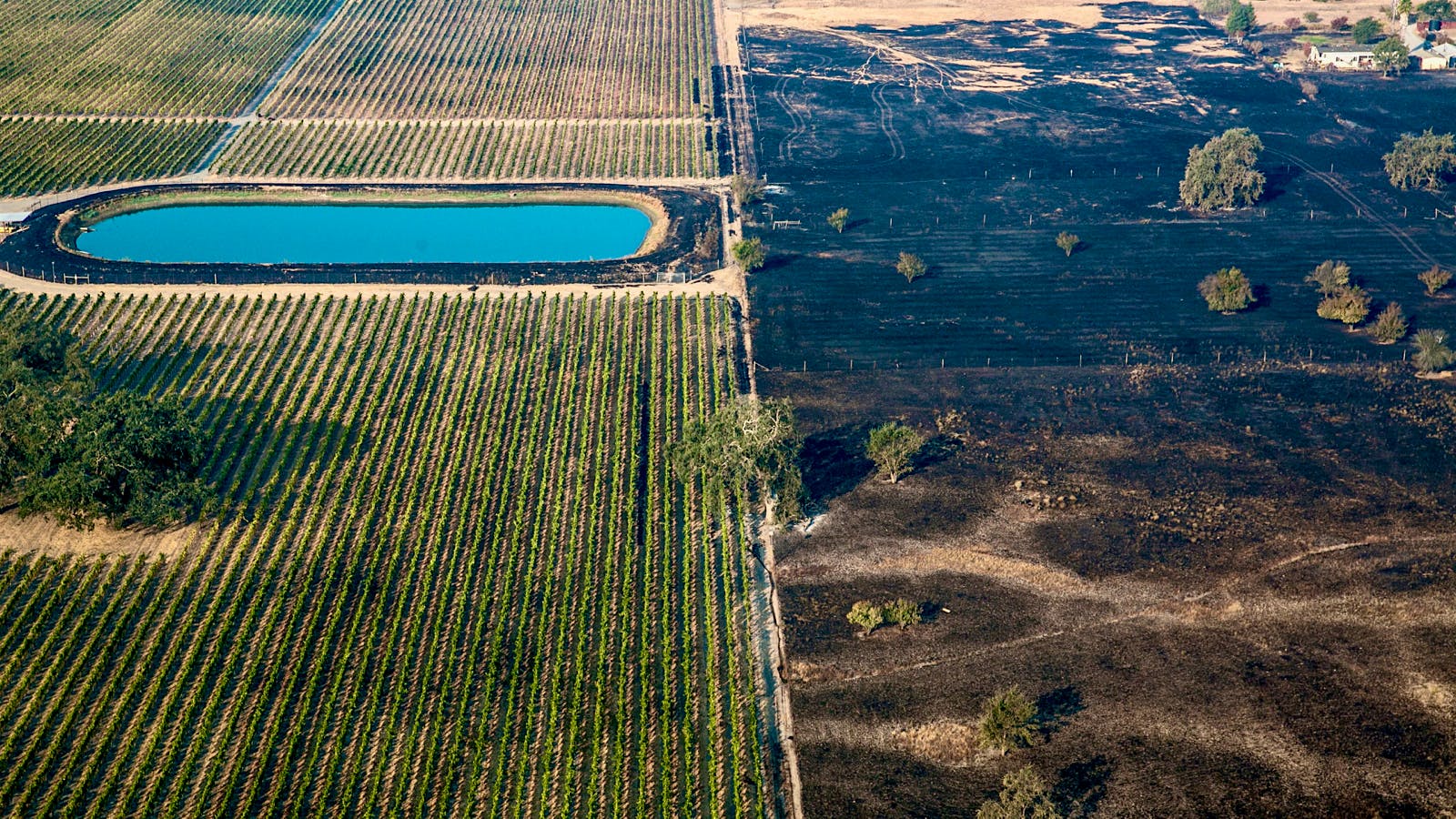Two weeks after the fires began in Northern California’s wine country, there is a growing sense that the worst may be over. Firefighters have contained the last of the blazes, and many restaurants and wineries are opening their doors. But there is still plenty of work to do as residents assess the damage from the deadliest wildfires in the state’s modern history.
A report by rating agency Moody’s projects that the wildfires, which have caused 42 deaths, destroyed nearly 8,000 buildings and burnt more than 210,000 acres, will cost California $4.6 billion. And that’s a preliminary projection the agency expects to rise.
Despite all the bad news, California vintners have a message they want wine lovers to hear. “The wine industry is OK,” said Gladys Horiuchi of the Wine Institute, an advocacy group that represents more than 1,000 wineries in California. She points out that most wineries suffered no damage, and the 2017 vintage shouldn’t suffer a major impact.
But the fires’ aftermath will affect the wine industry in many ways, some subtle and some obvious, for years to come.
Tourism Impact
“Many of Sonoma County’s wineries are open and welcoming guests,” said Jean Arnold Sessions, executive director of Sonoma County Vintners. “One of the best ways to support our beautiful, diverse and vast region is visiting the open tasting rooms.”
“If you drive up Highway 29, you don’t see any visible scarring,” added Clay Gregory, president and CEO of Visit Napa Valley. The well-known valley floor and main artery of Napa looks as pristine as it did two weeks ago. But blackened hills are visible in the distance. The Silverado Trail on the other side of the valley tells a different story. In one small stretch of the Stags Leap District, scorched groundcover goes all the way to the road. But only one tasting room in the area, Signorello, is gone. Darioush right next door still gleams in the afternoon sun.
Nearby, where Carneros and Sonoma Valley meet, an old dairy was reduced to ash, but across the street, Nicholson Ranch Winery stands relatively untouched, its vineyards still covered in leaves despite the charred hillsides surrounding them. This is a common sight throughout the area: charred hillsides and green vineyards.
One of the biggest challenges for the wine industry in the short term will be convincing tourists to return. Dr. Anita Oberholster of the University of California at Davis’ Department of Viticulture and Enology points out that Sonoma and Napa have a combined $1.93 billion tourist industry. Of the 650 wineries between the two counties, only a handful have reported debilitating damage.
But visitors may not realize that wine country is open for business, and that could hurt bottom lines. Rob McMillan, vice president of Silicon Valley Bank’s wine division, estimates that 25 percent of an average area winery’s revenue comes from its tasting room. “For now, that number is zero,” said McMillan. “Reduced tourism also hurts hotels, restaurants, local government and jobs within that sector.”
As roads and the air quality clear, employees are returning to work and wineries and tasting rooms are reopening. “We’re through the thick of it now, so we have to think of recovery,” said Michael Muscardini of Muscardini Cellars in Kenwood. “[Tourists] need to know that we are going to be resilient.”
Gundlach Bundschu, at the southern end of Sonoma, was one of the wineries most directly affected, as parts of its winery building suffered some damage and the family lost its house on the property. But they are back open for business, with tasting fees donated to local recovery efforts, and complimentary tastings for first responders.
Wine Impact
Behind the scenes, vintners are scrambling to finish the harvest. They’re also assessing damage to the vineyards and how that will affect their finances.
Fortunately, many of the vines should be fine. Vineyards have green, hard-to-burn foliage, with wide swaths of clear space around them. Singed leaves will not have much impact on future seasons of growth, but scorched grapevines might have an impact on yields in 2018. In a few extreme cases, where the flames burned hottest, vines will have to be replaced. Winemakers won’t know until winter pruning if their singed vines still have any life left in them.
While many have speculated that grape and wine prices may go up, that’s premature, says Honore Comfort, wine business executive in residence at the Wine Business Institute at Sonoma State University. “Napa and Sonoma counties have a total of over 100,000 vineyard acres combined. The fires affected only a small number of vineyards, and of those the damage was primarily on the fringe of the vineyard site,” she explained. “Grape prices in the North Coast are affected by many factors, however, the percentage of vineyard acres directly affected is minimal when viewed as part of the whole.”
Wine industry members are quick to point out that the majority of this year’s wines should be fine. Anywhere from 75 to 90 percent of the wine grapes had been picked by the time the fires started, based on various estimates. That includes nearly all white grapes and most of the reds. Those grapes that were on the vine were late-ripening reds like Cabernet Sauvignon. However, Cabernet grapes also typically fetch the highest prices, so while the percentage of the crop lost may be small, the percentage of lost revenue could prove higher.
Winemakers are carefully monitoring the remaining fruit they are picking, sending samples to labs to look for signs of smoke taint and fermenting affected grapes separately to assess their flavor. Winemaker Aaron Pott was looking carefully at the grapes picked post fires. “We want to get the grapes off as quickly as possible and as gently as possible to avoid issues,” says Pott. But he is not going to compromise on quality. “If [the wines can’t be bottled as single-vineyard blends] they will be sold in bulk, with severe cutback to the grower and of course the winery.”
Folio’s Robert Mondavi Jr. reported one of the most extreme cases of damage. Their organic vineyard on Atlas Peak was singed by flames that burned the cover crop and the end posts. Much of the crop couldn't be salvaged, so they will not produce their 2017 Animo.
Rebuilding Impact
It’s too early to project the rest of the fire’s economic impact. The Moody’s early figure was based on the estimate of 5,700 structures destroyed at an average value of $802,000 per structure. When asked, most wine experts point out that damage to wineries and vineyards is minimal compared to the thousands of homes lost in the area.
White Rock in Napa is one of the wineries listed as “destroyed,” but winery representative Heather Conlin explains that it’s a little more complicated than that. “There were a lot of reports that we were completely destroyed. And at times it feels that way,” said Conlin.
But while the buildings and much of the equipment are gone, most of White Rock’s 6,000 square feet of caves are safe. While some bottles of wine were lost, the majority of the wine’s inventory is safe at an offsite warehouse. The winery had also picked at least 75 percent of their grapes before the fires. That wine is secure in their caves.
The White Rock vineyard is also safe. “The property is leafy green; all around it is charred hillsides and burnt buildings,” said Conlin. “I think it’s hard for people to understand. How do you frame total destruction, but still picture this leafy green vineyard?”
The next phase will be rebuilding. “We have had quite a few phone calls this week from past clients and new ones, wanting to get on the waiting list to rebuild,” said Mark Grassi, president of Grassi & Associates, a construction company that builds custom homes and wineries in Napa and Sonoma. For now the focus is on establishing basic necessities such as running water and power.
On Wednesday, California Gov. Jerry Brown issued an executive order to speed up recovery efforts in Napa, Sonoma, Mendocino and other regions impacted by the wildfires. Provisions include suspending planning and zoning requirements, as well as state fees for manufactured homes and mobile-home parks. The order also allows wineries to relocate their tasting rooms.
Grassi estimates that the cost of rebuilding homes and wineries in Napa could easily run into the hundreds of millions of dollars and will take time. “It could be well over one to two years before they will be able to get up and running,” Grassi says. Properties will first need to be checked for hazardous materials, and then owners will need to engage an architect to draw up plans. Local banks are already announcing low, fixed-interest loan rates, forbearance on outstanding credit, payment deferrals and emergency loans.
Labor Impact
Grassi believes Napa County will need additional help as the process gets under way. “There was a labor shortage to begin with, and this is only going to make it worse.”
People are the wine industry’s biggest resource. As many as 3,000 homes were destroyed, affecting an estimated 15,000 people. Some employers, like Trinchero Family Estates, are using their Family in Need Fund and matching employee donations 2-to-1 to help employees who have been displaced or lost homes. Many other companies are providing temporary housing for displaced workers. Barbara Banke of Jackson Family Wines reported that 23 Jackson Family Wines employees lost their homes to the fires, and that the company has housed them all for now, either in winery guesthouses or other properties.
Affordable housing was already considered in shortage in Napa before the fires, and efforts were in place to address the situation. Now those will need to be accelerated. “This is not a new issue,” said Napa Mayor Jill Techel. “Last year we approved 800 units of housing, and 80 percent of them are rentals. There are also three affordable-housing projects approved. In this way, we are ahead of the game.”
Sonoma’s Santa Rosa was hit hardest, with 6,700 homes and businesses destroyed. It’s estimated that Santa Rosa lost 5 percent of its already-scarce housing stock. According to the U.S. Department of Housing and Urban Development’s Housing Market Analysis report from April 2017, the housing market was already “tight” with a vacancy rate of 0.9 percent, and rentals at 3.2 percent. The federal government is sending trailers to house people temporarily.
The housing shortage means that some homeowners may profit from rising equity valuation of their homes, and the subsequent insurance payouts. But there is a fear that some will decide to leave the area. High demand and low supply will probably result in higher housing costs for several years.
For now the focus is on helping each other. “There is a natural protocol everyone is following,” said McMillian. “First you take care of yourself and your family, and when everyone is safe, you make sure your employees and neighbors are safe. Then you can take care of repairs and get into recovery.”
“People are asking all the time how they can help,” said Conlin. “Continue to enjoy wine. We’re all committed for the long term. It takes all of us to keep our local businesses afloat.”
—With reporting by Aaron Romano and Augustus Weed












